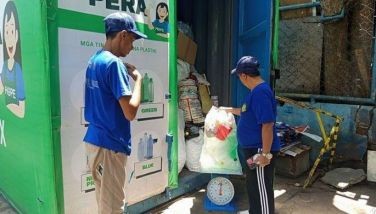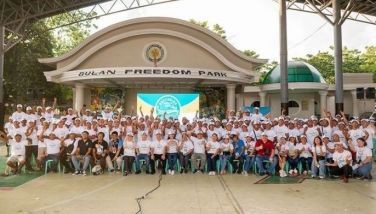Moving forward in 2016 after P-Noy

HAIKOU CITY— The most important leg of this first Philippine Media Southwest China Economic and Cultural Familiarization Tour organized by the Chinese embassy in Manila is the visit here to the province of Hainan. The Chinese name of this city means “the mouth of the sea.” This is the capital city of the island province of Hainan that is facing the nearest or closest to the Philippines.
The province of Hainan is one of the reference points of the so-called “nine-dashed line” of Beijing’s claims over the disputed areas in the South China Sea that overlaps with our own West Philippine Sea. China based its claims on a “nine-dashed line” map that extends to hundreds of miles south from its Hainan Island to equatorial waters off the coast of Borneo. It is considered one of the busiest navigation lanes, where ships from around the world pass through.
More than 100 islands, islets, reefs, shoals, atolls and assorted rocks above and below the overlapping territorial waters are being claimed in part by China, Taiwan, Brunei, Malaysia, Vietnam and the Philippines. Except for China and Taiwan, the rest are members of the Association of South East Asian Nations (ASEAN).
We were taken to a guided tour of the National Institute for South China Sea Studies (NISCSS) where framed photo replicas of supposed ancient Chinese maps invoking Beijing’s “indisputable” sovereignty over areas inside the so-called nine-dashed lines are on display.
One of these replica maps reads: “On October 7,1947, the Minister of Interior reported to Chiang Kai-Shek that the Spratlys and the Paracel Islands are New Names of the Islands. The Map of Position of the South China Sea Isles, which was published in 1948, contained 11 dashes. The documents have become an important historical and legal basis for China to safeguard her rights in South China Sea.”
As of this stage, only the “nine-dashed line” map of China has been elevated before the International Tribunal on Law of the Sea (ITLOS). The Philippines earlier this year initiated legal action against China for violation of the United Nations Convention on the Law of the Sea (UNCLOS).
Bringing this matter before the international court escalated the word war between Manila and Beijing. Both the Philippines and China have ratified UNCLOS, which, among other things, provided for dispute settlement through this international arbitration body. But China insists such misunderstanding can and must be settled through bilateral means only, without need to involve any third party.
Since the dispute has reached and pending before ITLOS, we were obviously taken at the NISCSS to listen and merely conduct academic discussions of this very sensitive issue between the two countries.
Incidentally, one of the framed photos of professors teaching at the NISCSS happened to be Dr. Rommel Banloi, an acknowledged Filipino expert on South China Sea studies. From what I gather, Banloi also serves as consultant at our own Department of Foreign Affairs (DFA).
For almost two hours, we had a no-holds barred question-and-answer from Dr.Wu Shicun, the president of the NISCSS who is regarded here as one of the key advisers of the central government on foreign policy issues, especially on the South China Sea. Established in 1996 as China’s foremost research center for South China Sea matters, the NISCSS was upgraded in 2004 to become “think tank” of Beijing’s foreign ministry specializing in South China Sea policies and related issues.
Wu impressed on us that he is someone who is in a position that can very much influence policy-makers in Beijing from the highest echelon of their central government. During his most recent visit to Beijing, Wu disclosed he saw and met with China’s ambassador to the Philippines Zhao Jianhau while both of them were apparently there to render their respective reports to the central government. By this time, the ambassador has reassumed his post in Manila to lead preparations for the 65th founding anniversary of the Communist Party of China that their embassy in Manila will celebrate on Oct. 1.
In his book about the South China Sea dispute, Wu expressed firm belief that bilateral negotiations for joint exploration and development of the mineral-rich part of the region remain the best option of peaceful settlement among claimant countries.
He cited as example the case of Malaysia after it agreed on bilateral negotiations with Beijing for joint development while setting aside for now their dispute on the South China Sea. Malaysia’s trade with China has ballooned to $100 million while Philippine trade with China amounted only to $20 million last year, Wu noted.
The South China Sea expert, however, conceded that the basic obstacle to reviving bilateral talks is the lack of mutual trust by both Manila and Beijing.
It did not help any when President Aquino gave his blessings to Senator Antonio Trillanes IV to do some unofficial “backdoor” talks with Chinese officials in Manila and in Beijing in the early part of 2013. Used to his brusque ways of doing things, Trillanes bullied his way to earn the trust of his Beijing contacts at the expense of former Philippine ambassador to China Sonia Brady. For lack of full understanding of the national issues at hand, his tactics backfired.
President Aquino instead became more adamant against China’s overtures for bilateral talks to ease tension on the disputed region. Accused by China as having pro-US bias, DFA Secretary Alberto del Rosario went full steam ahead to formalize the Philippine complaint before the ITLOS.
Wu disclosed he came to Manila last December when he met and had “long-table discussions” with academic, economic, defense and security officials in the Philippines regarding the China position on the issue. While in Manila, Wu had a separate breakfast meeting with a “senior official” of President Aquino. He claimed he cannot recall, or should I say he refused to say who this senior official is, but this Aquino official supposedly told him what could be the flimsiest reason why the Philippines elevated the case to ITLOS.
“In the Philippine tradition, to solve a problem is to go to court. Many of our politicians are lawyers. That’s why,” Wu quoted this “senior” official.
Wu said another option is for the Philippines to withdraw the arbitration case against China “as a goodwill gesture.” In turn, Beijing should not bother Filipino fishing activities around the disputed areas. That’s the least that China can offer other than removing or dismantling permanent structures it put up in certain parts of the disputed Spratlys.
To break the barrier of distrust, Wu suggested a high-level meeting between President Aquino and President Xi Jinping could mend the relations of the two countries. Such a meeting between the two presidents could take place on the sidelines of the Asia Pacific Economic Council (APEC) Leaders’ summit to be hosted by Beijing in November.
However, it seems to be wishful thinking. Fresh from his four-nation state visits in Europe last week, P-Noy succeeded to elicit expressions of support from his counterpart leaders of key member states of the European Union to support the Philippine position for peaceful settlement of the South China Sea dispute through international arbitration.
Bilateral relations between the two countries have undeniably soured since the Aquino presidency’s pro-US bias became more obvious from China’s point of view.
There is still, however, avenues for a more sober settlement of the dispute without either Manila or Beijing losing face before the eyes of the world. It is just a matter of waiting for a more opportune time. As China sees it, it may come after P-Noy steps down in June 2016.
- Latest
- Trending

























